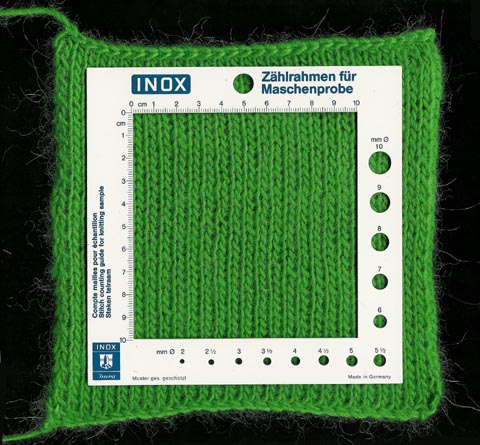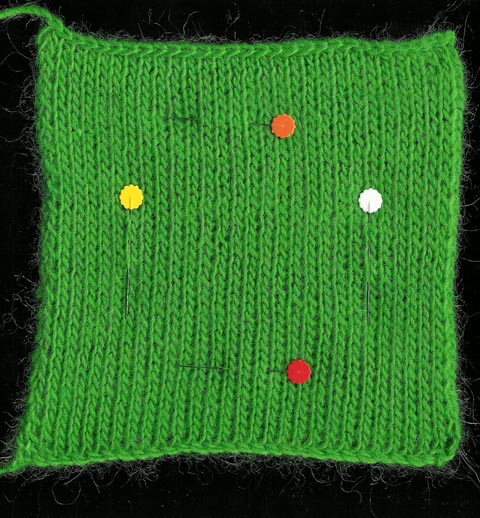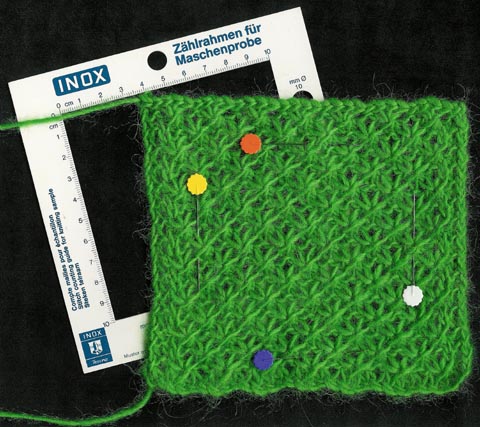3: Tension
Tension is the measure of the number of stitches and rows that
make up a certain area. Itís the foundation of a knitting pattern
and correct tension is the most important discipline of knitting.
Buy a good tension measure or use a ruler. A tape measure can move
when measuring, so only use one as a last resort.
If you are knitting a garment of your own design, the first thing
you will need to know is how many stitches are necessary for the
required width. Because knitting is gathered on to needles, it is
impossible to measure across the width until many rows have been
completed. Calculating the correct number from the tension means you
will avoid lots of unpicking and re-knitting.
Length is a different matter. You can measure this easily, but if
you are working a neck that has to be a particular depth, or needing
to fit in pattern repeats or a placing a design, you will have to
know the exact number of rows.
The tension, needle size and finished measurements are always stated
at the beginning of a knitting pattern, and if the garment is to be
the size expected, tension must be correct. The pattern writer uses
the tension to calculate the size of the finished garment, and
doesnít need to knit any more than a tension square to design the
whole pattern.
The only way to ensure that your garment will be what you expect,
and what the pattern writer has intended, is to work a tension
square and make sure that the tension matches exactly.
---
Making and measuring a tension square
Tension is usually measured over ten
centimetres or four inches. Using the needles and yarn suggested in
the pattern, or a yarn that you have chosen, cast on ten more
stitches than the number needed for ten centimetres. Working in the
stitch over which the pattern states that the tension has been
measured, knit ten more rows than the number needed to make ten
centimetres. Cast off loosely.
Itís best to knit a large square so that you can measure the
stitches easily without distorting the piece of knitting. Another
reason is that when you knit, there is a natural tension which you
donít settle in to immediately. A small tension square can be
tightly knitted, and bear little resemblance to the true tension
achieved when actually knitting the garment.
Look at the pattern to see if the tension instructions suggest
ironing. If so, use a cool iron and donít stretch the square.
To measure, place the square on a flat, non shiny, surface. Never
measure when holding the knitting over your knee or the arm of your
chair. The measurements will not be accurate. Smooth out the square
by patting it gently, then place a measure, tape or ruler on the
fabric. Without moving the fabric or the measure, place a pin at the
measurement you need. Just stick the pin straight in and after you
have moved the measure, anchor the pin firmly into the fabric. Count
the number of stitches and rows between the pins [pic 1,2].

1: Place the
measure over the tension square. Count the number of stitches
without touching the knitting for an accurate result.

2: The pins
mark the measurement.
Repeat on a slightly different area to make
sure you are right. This is now your tension with those needles and
that yarn.
Pattern stitch knitting is measured in the same way as plain
knitting, but make sure the marking pins are anchored firmly as you
may have to pull at the stitches to get an accurate count. Pattern
stitches often hide behind each other, and it is essential to know
the correct number of stitches in a pattern sequence [pic 3].

3: Anchor pins firmly on patterned knitting.
NEXT PAGE >>
chapter page: 1 | 2 |
3 |